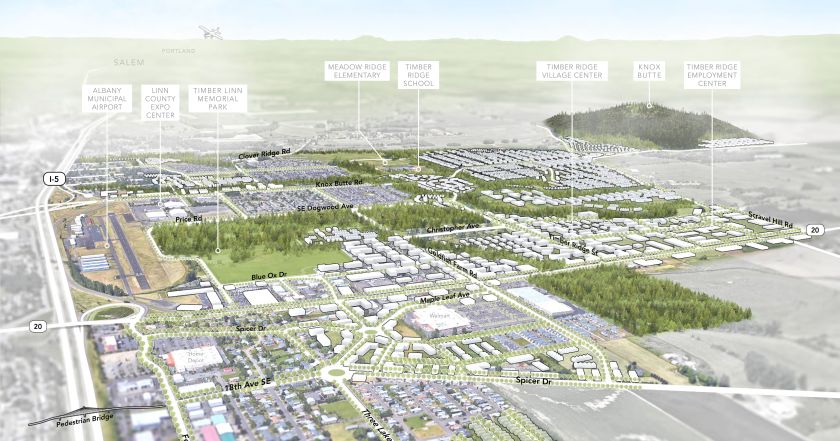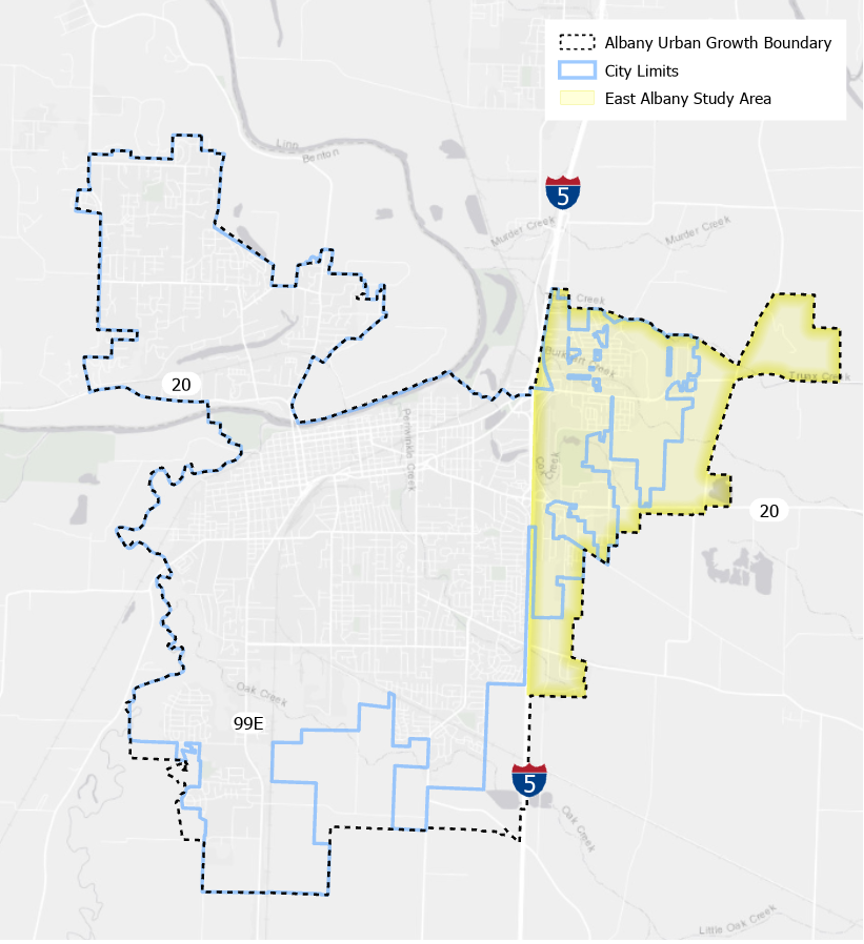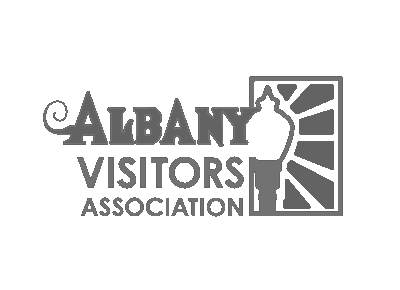East Albany Plan Adoption
The East Albany Plan provided an opportunity to take a fresh look at land within the city’s Urban Growth Boundary east of Interstate 5 and create a new plan focused on connectivity, transportation choices, housing variety, employment centers, and vibrant and walkable mixed-use areas, while protecting the area’s natural resources and viewsheds.
The East Albany Plan is a long-range guiding document that will help the city plan for future residential, employment, commercial growth and associated utility, facility, and transportation needs.

Adopted Documents
The City Council adopted the East Albany Plan and associated amendments to the Albany Comprehensive Plan and map, the Zoning map, and Albany Development Code on May 10, 2023. The amendments go into effect July 1, 2023.
Ordinance 6010 with exhibits
Individual exhibits are below:
Overview
Project Overview – Why this Plan?
East Albany represents a key growth area for the City, with a large land base that represents much of the community's future growth and expansion. Since the 2001 "East I-5 Plan" was prepared, the area has seen housing growth, as well as development of larger commercial businesses and light industrial facilities. However, development of neighborhood commercial services and creation of an integrated transportation, parks and trails system has lagged. It's time to take a fresh look at this key growth area for the City and create a new plan focused on connectivity, transportation choices, housing variety, and vibrant mixed-use and employment centers around the area’s natural resources and viewsheds.
This project is funded through a grant from the State of Oregon's Transportation and Growth Management (TGM) program, a partnership between ODOT and the Department of Land Conservation and Development (DLCD). The City of Albany has hired a multi-disciplinary team of consultants to assist with this effort, including APG, Walker Macy, Johnson Economics, DKS Associates, and Keller Associates.
Area
This project will address the area shown in the map below. This land is within the Albany Urban Growth Boundary east of I-5 and totals about 2,800 acres. The City’s largest park, Timber Linn Park, and the Linn County Fair and Expo Center are located in the western portion of the Study Area near I-5. Most commercial development in East Albany is along US 20 or near I-5 and has a regional draw (Walmart, Home Depot, car sales) or caters to travelers. A collection of properties zoned Regional Commercial adjacent to the Knox Butte interchange remain underdeveloped with low-density residential uses. Recent development has included both traditional residential neighborhoods with single-family homes, as well as more recent development of apartments.

Conditions and Challenges
East Albany faces several significant transportation challenges, including travel generated by regional destinations in the area, connectivity issues, the need for direct access to properties near I-5, limited pedestrian and bicycle facilities, and traffic expected from future housing development.
A variety of tools will be evaluated and potentially implemented to help address these issues, including an emphasis on mixed-use development and complete communities to reduce vehicle trips, development of a robust bicycle and pedestrian network, event traffic management strategies, and relevant direction from previous planning efforts, including the Regional Transportation Plan, Transit Development Plan, and ADA Transition Plan.
East Albany contains several streams and wetlands which can be desirable amenities for future residents when incorporated into a network of trails and natural areas. However, these features can also be challenging for the creation of well-connected transportation and infrastructure systems.
Scope and Schedule
Plan Scope and Schedule
The East Albany Plan aims to:
- Connect residential, employment, commercial, and recreational uses with a functional and safe multi-modal transportation system and interconnected greenway trail system.
- Create transportation system that provides access and mobility while supporting anticipated residential and employment growth.
- Create attractive gateways into Albany from I-5 and US 20.
- Increase the variety of housing types, densities, and mixed-use developments to accommodate the needs of current and future residents.
- Protect the area’s riparian and wildlife corridors, wetlands, and drainage ways located within significant natural resource overlays.
- Use interconnected natural resource corridors to provide pedestrian, open space, and wildlife connectivity between neighborhoods and help protect scenic vistas.
- Identify opportunities to provide aesthetic and recreational amenities.
- Identify a strategy for implementation, including short-term and long-term measures the City can take that will help achieve its goals for East Albany.
The anticipated project schedule is shown here represents the team’s goals for completing key milestones in the planning process. It is subject to change, in the event that unforeseen circumstances cause project delays or necessitate course corrections. The project has several distinct phases:
- Project Initiation - Summer 2021. This kickoff task includes establishing the project's advisory committees, project informational materials, and early stakeholder outreach.
- Vision and Conditions for East Albany - Fall 2021. This step will detail the existing conditions in East Albany and establish the project's guiding vision and objectives.
- Public Event #1 - Winter 2021. This is the first major touchstone with the broader community for this process. Public Event 1 will focus on the community's vision for East Albany and will inform later steps in the process.
- Gap Analysis - Winter 2021/2022. This step will take a close look at gaps in the transportation system, missing housing opportunities, and the challenges to and benefits of creating an interconnected system of parks, trails and natural areas.
- Scenario Development and Analysis - Winter/Spring 2022. This step will create alternatives for land uses and the transportation system in East Albany and analysis of how well these alternatives meet the project's goals.
- Public Event 2 - ummer 2022. This is the second major touchstone with the broader community, focusing on the plan alternatives developed in Step 5. Community input will help craft a preferred alternative for East Albany.
- Plan Development and Implementation - Fall 2022. This step will include developing the plan and will address needed amendments to the City's Comprehensive Plan and Development Code, infrastructure needs, and a funding plan in order to implement the preferred alternative.
- Adoption - Fall 2022/Winter 2023. This step will include plan adoption hearings of the Albany Planning Commission and City Council.
Engagement
Community Engagement
How can you get involved?
Public events
October 6, 2022
At Linn County Fair & Expo Conference Center.
October 2022
Online Open House Survey
June/July 2022
At City Hall
May 31, 2022
Community Conversations event at Cascade Grill.
November/December 2021
The first public event is was an online open house in November and December of 2021. View the event summary here.
Focus groups
Residents, property owners, businesses, and community leaders will participate in three focus groups at key project milestones. See Focus Group Summaries on the Project Documents Tab.
Project Advisory Committee (PAC)
The PAC’s role is to review all project deliverables and community input and provide guidance to the city and consultants. The PAC includes businesses, residents, and property owners in the study area, Greater Albany Public Schools, Albany Bike/Pedestrian Committee, Cascades West Council of Governments, Oregon Department of Transportation, Linn County, and City public works and parks and recreation departments. Six PAC meetings are scheduled throughout the various phases of the project. The PAC roster and meeting materials are listed below.
Planning Commission / City Council Work Sessions
The Albany Planning Commission and City Council will hold four joint work sessions throughout the project to review project deliverables and community input and provide input throughout the project. Meeting materials, minutes, and audio can be found on the Planning Commission website.
Written feedback
You can provide written feedback anytime by emailing
East Albany Plan Project Advisory Committee
This project will be guided by a Project Advisory Committee (PAC), which will meet regularly to review project materials.
Members
There are no documents available for this group in 2024.
Public Meetings Law Grievances
OAR 199-050-0070 requires us to publish contact information for submitting a grievance alleging violation of the Oregon public meetings laws. Written grievances may be submitted by email to
Documents
Project Documents
Project documents and other materials will be available on this page. The most recent materials are at the top of the list.
- Preferred Land Use Plan (3.52MB pdf)
- Streets Plan (3.5MB pdf)
- Trails, Paths and Bike Lanes Plan (1.32MB pdf)
- Transportation Analysis and TSP Amendments (1.31MB pdf)
- Infrastructure Analysis (1.31MB pdf)
- East Albany Transportation Evaluation Memo (818KB pdf)
- PAC 8-30-2022 Meeting Slides: Analysis of Scenarios (8.48MB pdf)
- Development Scenarios Report 8-24-2022 (3.42MB pdf)
- Transportation Gap Analysis 1-20-2022 (353KB pdf)
- Revised Vision and Goals (207KB pdf)
- Public Focus Groups Round 1 Summary (319KB pdf)
- Open House #1 Summary (1.71MB pdf)
- Market Analysis 9-29-2021 (3.06MB pdf)
- GAP Analysis Report 1-20-2022 (2.75MB pdf)
- Existing Conditions Presentation 10-11-2021 (4.84MB pdf)
Contact
Questions? Contact us!
If you would like to be added to our interested parties email list to receive periodic updates about the project, sign up under the Community Engagement tab.
If you have other questions or want more information about the project, please contact the City’s lead planner and project manager for this effort, Anne Catlin at 541-917-7560 or
- Details
The South Albany Area Plan (SAAP) represents the culmination of an 18-month planning project that presents the community vision for South Albany, Albany's largest undeveloped area.
It sets the direction for future growth and development in this area including zoning and land use, streets and highways, railroads, natural areas and wildlife along Oak Creek, neighborhood services, and development standards. Additionally, the SAAP identifies how much development can be approved before the realignment of Ellingson Road is required.
Study Area
The study area is generally all lands between Interstate 5 on the east and Highway 99 on the west, and vacant lands surrounding Oak Creek on the north, then south to the Urban Growth Boundary.

Project Objectives
The City’s goals were to lay the framework to create a vibrant new community that will be appealing to residents and businesses seeking new sites. The project objectives were to.
- Identify feasible patterns of land uses that are consistent with the City's goals for urbanization and environmental protection.
- Consider the capacity of existing, planned, and needed infrastructure facilities to serve the new development in a logical and orderly manner.
- Identify transportation facilities needed for circulation of motor vehicles and people walking and cycling.
- Provide rail service to industrial properties by protecting existing and future right-of-way for service to industrial properties.
- Reduce reliance on automobiles for short trips within the area, and between the area and surrounding development.
- Establish alignment and design standards for the Oak Creek Parkway to create a street that defines the southern edge of open space along Oak Creek, provides accessibility to parks and recreation facilities and that is integrated with surrounding development and other transportation facilities; prepare recommendations for low-impact development for environmentally-sensitive areas within the vicinity of Oak Creek.
Plan
View the South Albany Area Plan
Introduction
- Purpose of Project
- Study Area
- Document Contents
- Planning Process
Existing and Future Conditions
- Planning Area Context
- Past Planning in South Albany
- Existing Land Use Conditions
- Existing Transportation Conditions
- Market Analysis Summary
- Buildable Lands Analysis
South Albany Area Plan
- Overview
- Vision and Plan Objectives
- Organizational Framework
- Streets Framework
- Trails Framework
- Park and School Concept
- Land Use Plan
Implementation
- Comprehensive Plan and Zoning
- Transportation System Plan
- Funding Strategy
Appendix
- Appendix A – Task 1: Project Kick-off
- Appendix B – Task 2: Existing and Future Conditions
- Appendix C - Public Event #1
- Appendix D - Land Use and Transportation Alternatives
- Appendix E - Public Event #2 and Preferred Alternative
- Appendix F - Plan Implementation
- Appendix G - Public Event #3
- Appendix H - Plan Adoption and Code Amendment Recommendations
- Details
The general purpose of this Code is to set forth and coordinate City regulations governing the development and use of land. It also serves as the principal vehicle for implementation of the City’s Comprehensive Plan in a manner that protects the health, safety, and welfare of the citizens of Albany.
The articles below reflect CURRENT REVISIONS by City Council, effective August 9, 2024.
- ADC Table of Contents (102KB pdf)
- Article 1-Administration and Procedures (489KB pdf)
- Article 2-Review Criteria (300KB pdf)
- Article 3-Residential Zoning Districts (417KB pdf)
- Article 4-Commercial and Industrial Zoning Districts (2.46MB pdf)
- Article 5-Mixed Use Zoning Districts (1.21MB pdf)
- Article 6-Natural Resource Districts (1.1MB pdf)
- Article 7-Historic Overlay District (1.06MB pdf)
- Article 8-Design Standards (4.96MB pdf)
- Article 9-On-Site Development and Environmental Standards (1.73MB pdf)
- Article 10-Manufactured Home Development Standards (232KB pdf)
- Article 11-Land Divisions (420KB pdf)
- Article 12-Public Improvements (1MB pdf)
- Article 13-Signs (681KB pdf)
- Article 22-Use Categories and Definitions (1.02MB pdf)
- ADC Amendment Record (260KB pdf)
- Details
The Albany Comprehensive Plan provides a framework for making better decisions about the uses of land and its resources. It is a guideline for both short- and long- term development.
ADOPTED DECEMBER 17, 1980
Since 1980, this plan has been amended periodically as part of an ongoing update of the Albany Comprehensive Plan. Amendment Record for a complete record of revisions.
- Introduction (72KB pdf)
- Table of Contents (129KB pdf)
- Chapter 1-Natural Resources (Goal 5) (368KB pdf)
- Chapter 2-Special Areas (Goal 5) (219KB pdf)
- Chapter 3-Economic Development (Goal 9) (672KB pdf)
- Chapter 4-Housing (Goal 10) (364KB pdf)
- Chapter 5-Transportation (Goal 12) (98KB pdf)
- Chapter 6-Public Facilities (Goal 11) (292KB pdf)
- Chapter 7-Social Amenities (Goals 5 and 8) (225KB pdf)
- Chapter 8-Urbanization (Goals 13 and 14) (3.13MB pdf)
- Chapter 9-Land Use Planning (Goals 1 and 2) (257KB pdf)
- Chapter 10-Demographics Removed by Ordinance 5951 (99KB pdf)
- Chapter 11-Maps (3.51MB pdf)
- Appendices (2.77MB pdf)
- Amendment Record (172KB pdf)
- Details



